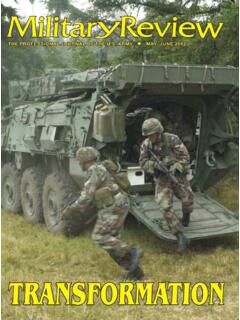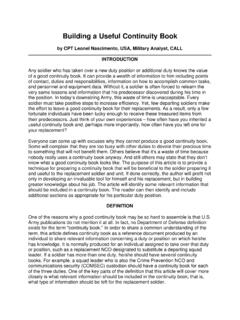Transcription of This is My Squad - Army University Press
1 NCO Journal1 September 2020 NCO Journal provides a forum and publishing opportunity for NCOs, by NCOs, for the open exchange of ideas and information in support of training, education and is My SquadBy Sgts. 1st Class Christopher Dunlap, Joshua M. MacNary, 1st Sgt. Jacob Miller, Sgts. 1st Class J. Andrew Porter, and Josephine M. PrideBenavidez Leader Development Program, Military AcademyShortly after assuming the duties of Sergeant Major of the Army (SMA), Michael A. Grinston set forth an initiative entitled, This is My Squad (TIMS).
2 The goal of the initiative is to build more cohesive teams throughout the Army. Grinston identified that both the Ranger Regiment and Special Forces units tend to exhibit greater team cohesion than traditional Army units. Their training is intense and creates shared hardships that all team members must bond together to endure. Additionally, because of the closeness of these teams, they usually have better knowledge of each individual team member and their families. This helps unit leadership effectively anticipate problems that may arise so they can prevent or fix them early (Rempfer, 2019).
3 TIMS comes on the heels of the Army People Strat-egy, proposed by Gen. James McConville, 40th Chief of Staff of the Army. The strategy focuses on deliberately managing the talents of the Total Army Force to increase readiness. People are the Army. They are our greatest strength, our most important weapon system (Kim-mons, 2019, para. 15). The concept is intended to move the Army away from a reliance on systems and tech-nology, and put the focus back on its people in prepa-ration for the future fight. With this goal in mind, SMA Note: The following article provided the concept for the future TIMS App.
4 ( Army photo by Sgt. Megan V. Zander taken Dec. 18, 2019) Army Soldiers with 2nd Armored Brigade Combat Team, 1st Cavalry Divi-sion prepare to approach a target during Squad -level live-fire training in Rukla, Lithuania, Dec. 18, 2019. NCO Journal2 September 2020 NCO Journal provides a forum and publishing opportunity for NCOs, by NCOs, for the open exchange of ideas and information in support of training, education and requested that one team from Cohort Five of the Benavidez Leader Development Program at the Military Academy, West Point, New York examine the TIMS concept and predict any problems that may affect team cohesion as well as offer possible noncommissioned officers (referred to as Team 3 )
5 Identified an overarching theme of ownership that team and Squad leaders should possess to be effective. After Team 3 s discussion and research, it was decided the most important factors to focus on to ensure teams would build cohesiveness would be: in-processing of new Soldiers to teams, noncommissioned officer (NCO) educa-tion throughout the Army, know your people in order to develop the individual and the team, and ensuring proper leader development. The following sections look at possi-ble solutions the Army could implement to create better leaders at the lowest level to improve team cohesion throughout the 3 looked over a broad list of possible topics com-municated from SMA Grinston and concluded that an overarching theme of ownership applied to the majority of these topics and is applicable to any unit level in the Army.
6 Individually, Soldiers demonstrate ownership over their physical, mental, and occupational development while also updating personal records, and other important aspects of their career. Although individual ownership is important, successful teams cannot depend solely on individual ownership to foster full team cohesiveness. Ownership must also be demonstrated by unit leaders , especially at the Squad and small group level. Squad and platoon leaders must take ownership of training, support-ing, and caring for the members of their of New Team MembersReception and integration, often referred to as in-processing, is the first moment a Soldier is exposed to their new team.
7 There are many inconsistencies in how a new Soldier might go through in-processing. Having an assigned sponsor in the Army Career Tracker or a battle buddy assigned to show someone around is only a small step in the overall experience, and one that is sometimes not done thoroughly (Bugala, 2017).In-processing is a critical time for setting a Soldier up for successful socialization to their new unit and team culture. Team culture is defined as the way a set of peo-ple behave and think which stems from the attitudes and belief system that they all share.
8 A collection of people that are working together to achieve a common goal and objective ( What is Team Culture, 2019, para. 2). This forms the basis for how team members interact and the type of environment in which teams operate. If the Squad leader does not take ownership of getting to know new Soldiers and properly introduce them to team members and culture, they may feel left out. Or worse, the Soldier may negatively affect the climate of the team, if, for in-stance, another team member instills the wrong ideas in the new Soldier s understanding of the culture.
9 This can lead to issues with team ensure unit leaders understand how to assimilate new Soldiers into the team culture, it is important new members are trained in positive cultural socialization. It is essential Soldiers are trained early in their career to be good follow-ers, team members, and leaders . Training in socialization, team/group dynamics, and strong team culture can be applied in Advanced Individual Training and Basic Leader Course. By doing so, junior Soldiers can establish a solid foundation early to build effective leadership and the Noncommissioned Officer Profes-sional Development System (NCOPDS)When a Soldier is promoted into the NCO ranks, they should be transferred out of their current Squad or platoon in order to facilitate fresh leadership dynamics.
10 There is the possibility current team members would still ( Army photo by Sgt. Amada Hunt taken April 23, 2020) Army trainees with the 434th Field Artillery Brigade conduct phys-ical readiness training during basic combat training at Fort Sill, Oklahoma, April 23, Army Soldiers arrive from one station unit training at Fort Ben-ning, Georgia to Fort Riley, Kansas to begin in-processing, April 17, 2020. ( Army photo by Sgt. Timothy Brokhoff )NCO Journal3 September 2020 NCO Journal provides a forum and publishing opportunity for NCOs, by NCOs, for the open exchange of ideas and information in support of training, education and them as an equal.














